It’s not an exaggeration to say Hedrick was ecstatic when she peered into her inverted phase contrast microscope and found Amphisolenia quadrispina floating in her sample. “For 20 years I’ve been hoping to see something like this,” she said. A. quadrispina has a unique long, thin shape that resembles a stick, more than it does other dinoflagellates. It’s huge too — between 600 to 700 microns, which is still smaller than the tip of a needle, but large by phytoplankton standards.
Click to continue »
From the Bay of Bengal, a dinoflagellate makes its way to the Smithsonian
Posted by Kristen Goodhue on January 22nd, 2010Better Know a Trace Element: Mercury
Posted by Kristen Goodhue on January 11th, 2010An interview with Cindy Gilmour, mercury researcher.

Senior scientist Cindy Gilmour studies how anaerobic bacteria – found in places like the marsh soils above – transform mercury into methylmercury. Methylmercury poses a bigger problem than inorganic mercury because it bioaccumulates.
This January the Maryland Healthy Air Act goes into effect. It aims to significantly reduce emissions of air pollutants from the state’s coal-fired power plants. Mercury, like sulfur dioxides and nitrogen oxides, is one of the pollutants that can be released into the atmosphere during the combustion of coal and other fuels. The new law requires mercury emissions to be reduced by 80% now, and 90% by 2013, relative to a 2002 baseline. Maryland is just the latest to join a growing roster of states that have adopted tougher emissions regulations.
Cindy Gilmour will pay close attention to the impact of these new regulations on mercury levels in the Chesapeake Bay and its watersheds. Gilmour is a senior scientist at the Smithsonian Environmental Research Center (SERC), in Edgewater, Maryland. She took a few minutes to answer some questions about the science of mercury, why it’s of concern and what she does to monitor it in ecosystems.
Click to continue »
This little orchid prefers winter
Posted by Kristen Goodhue on January 8th, 2010Forget about a tree growing in Brooklyn, there’s an orchid growing in the snow. Its name is Aplectrum hyemale. It’s a clever and contrarian little thing.
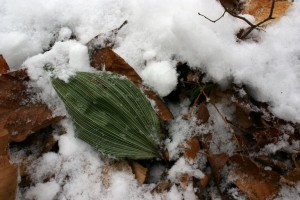
The orchid Aplectrum hyemale is not afraid of a little snow. Winter is the perfect time for it to photosynthesize.
Aplectrum hyemale waits until the fall to unfurl a solitary leaf. It’s an ellipse of broad green with thin cream stripes. The plant sits low to the ground. In the summertime it would have to compete like crazy for an ounce of sunlight. And it would likely lose out to oaks, tulip trees and the like. During the winter though, after the forest canopy has been stripped bare, Aplectrum hyemale can get all the rays it needs. So a winter green it is.
Click to continue »
A free trip to the Caribbean
Posted by Kristen Goodhue on December 23rd, 2009Yesterday we gave you a glimpse of Saudi Arabia’s mangroves. Today we offer you free passage to the Caribbean. Smithsonian Environmental Research Center senior scientist Ilka “Candy” Feller organized this virtual tour of Mangal Cay, a mangrove island in the tropics. You can journey with her through the forests and underwater to learn more about the ecology of mangroves. This virtual tour was supported by the National Science Foundation. Click the image below to start the voyage.
The tour’s also available in Spanish. Happy travels.
Beyond the desert: Exploring Saudi Arabia’s mangroves
Posted by Kristen Goodhue on December 22nd, 2009Dennis Whigham and Candy Feller both noticed the mangroves’ odd shape. “They almost looked like bonsais,” said Whigham. The shrubs had mature trunks, but the shoots were all new. Feller and Whigham are ecologists at the Smithsonian Environmental Research Center (SERC). To their trained eyes, these trees looked like they were recovering from something like a hurricane. These mangroves survived a different kind of storm: camel grazing.
Saudi Arabia conjures images of the desert, but along the Red Sea coast there are pockets of green dominated by mangroves. Feller and Whigham hunted around for these mangroves during a November visit to the country. They are part of a team of ecologists that’s partnering with the staff of the new King Abdullah University of Science and Technology (KAUST). The school is located on the Red Sea in city of Thuwal.
Snow falls on the ruins
Posted by Kristen Goodhue on December 18th, 2009It’s Friday and the weekend forecast calls for snow here in Edgewater, Maryland. With that in mind, here’s a frosty photo and poem.

The Contee Mansion Ruins at the Smithsonian Environmental Research Center, in Edgewater Maryland. Photo by Chuck Gallegos
Senior scientist and avid photographer Chuck Gallegos took this wintry image of the Contee Mansion. The ruins are part of the Smithsonian Environmental Research Center (SERC). SERC officially acquired the property in 2008. We’re now working to stabilize the structure and prepare it for future use. Archeologists have guided volunteers in past research excavations. More digs will take place once the weather warms up. Eventually the ruins will be part of an interpretive trail that explores the history and ecology of the old farm.
Now for the poem. This month marked what would have been Emily Dickinson’s 179th birthday. The Massachusetts native had a rich education in science and natural history at what is now known as Amherst College. Many of her poems are infused with her botanical knowledge. Dickinson had her own herbarium and flowers are a reoccurring subject of her work. You won’t find any petals or stems in this winter poem.
The Sky is low – the Clouds are mean.
A Travelling Flake of Snow
Across a Barn or through a Rut
Debates if it will go –
A Narrow Wind complains all Day
How some one treated him
Nature, like Us is sometimes caught
Without her Diadem.
— by Emily Dickinson
You can read more about Emily Dickinson and her education in science and natural history at The Poetry Foundation.
Climate change may drastically alter Chesapeake Bay, scientists say
Posted by Kristen Goodhue on December 3rd, 2009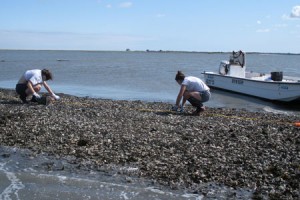
Smithsonian researchers Lori Davias and Jenna Malek collect oysters on an intertidal reef in the Chesapeake Bay. It is difficult to predict the effect of climate change on oyster populations because increasing temperatures will likely have at least two opposing effects. On one hand, intertidal oyster populations may be able to expand northward as winter temperatures rise. On the other hand, increasing summer temperatures are likely to worsen the problem of low oxygen concentrations and may reduce the extent or suitability of some subtidal habitat currently used by oysters. At this point, scientists are unable to predict whether the combination of these two factors will result in a net increase or net loss of habitat. Photo: Sean Fate
Using forecasts of atmospheric carbon dioxide production for the coming century, the scientists predict the water of the Bay will see rising levels of dissolved carbon dioxide and higher water temperatures. As a result, climate change is expected to worsen problems of low dissolved oxygen concentrations in the Chesapeake’s water and cause sea levels to rise.
Click to continue »
Wetlands on the rise, a conversation with biogeochemist Pat Megonigal
Posted by Kristen Goodhue on December 1st, 2009Pat Megonigal is a biogeochemist here at the Smithsonian Environmental Research Center (SERC). The following is an interview with him about his recent research.
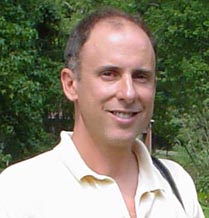
Smithsonian biogeochemist Pat Megonigal
Climate change scenarios are driven largely by greater concentrations of carbon dioxide in the atmosphere. One common narrative includes faster-rising seas and the potential drowning of coastal regions. You recently published a paper in the Proceedings of the National Academy of Sciences that gives hope to some coastal wetlands. Tell us what you found.
PM: We conducted a study for two years on the Kirkpatrick Marsh, here on the Chesapeake Bay. We discovered that higher levels of atmospheric CO2 actually stimulated the surface elevation of saltwater marshes. The additional CO2 caused them to basically pop up, or rise in elevation, because the plants developed more roots. It’s kind of a silver-lining story.
How did you simulate climate change?
PM: We put out clear open-top chambers that are about two yards in diameter. They allow us to manipulate the atmosphere around a chunk of marsh. Then, in some of the chambers, we pumped in extra CO2; we raised it to a level that will be roughly what the whole world will be exposed to at the end of the century. And then we measured the changes in the soil’s elevation throughout the growing season.
When you think of measuring elevation, mountains come to mind, not soil. How did you measure the soil’s height?
PM: Well, we needed a stable point of elevation reference, so first we drove a steel rod about 20 feet into the ground. Then came the hard part. We had to design a tool that would give us not only precise, but multiple measurements of the soil elevation – both in and outside of our chambers. We came up with an instrument we dubbed the “monster arm.”
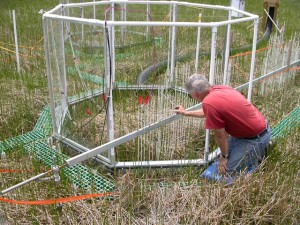
Technician Jim Duls measures the soil elevation with the 'monster arm.'
The monster arm?
PM: The technical name is “surface elevation table.” Basically it’s a long metal bar with 90 fiberglass pins running perpendicular through it. It looks like a big comb, but instead of the teeth being fixed in place, they can move up and down. So by gently placing the monster arm across the chambers we could measure where the top of each pin was in relation to the main crossbar. So if a pin rose 100 millimeters above the bar in April and in August it rose 102 millimeters, the soil elevation increased by two millimeters.
Your study showed that the marsh receiving the extra CO2 rose by an additional 3mm a year. Is that enough to keep pace with the rising sea level?
PM: It should help for a while, but we don’t know how much sea level rise a marsh can handle before it will disappear. We do know that rising sea level is one reason that some marshes in mid-Atlantic and around the world are disappearing right now. Our research indicates that some of these wetlands literally have an organic ability to fight back by building new soil. This is especially true for wetlands with brackish water, like Kirkpatrick Marsh. Saltier coastal wetlands won’t be able to accumulate as much soil because their plants are different and don’t respond to CO2 in the same way. But we’re now conducting a new experiment to look at sea-level rise and its effect on soil elevation. We think the pop-up effect we’ve observed will be even more pronounced when the water level rises. We’ll see!
Happy 150th ‘Origin of Species’
Posted by Kristen Goodhue on November 24th, 2009On this day in 1859, Darwin went public with his case for the theory of natural selection. The arguments he set forth in The Origin of Species, have guided scientific explorations of evolution ever since. The biologists and ecologists here at the Smithsonian Environmental Research Center apply Darwin’s theory perhaps as much as they do soap. They may use modern genetics to investigate rare orchids, blue crabs and parasitic dinoflagellates – but Darwin’s discoveries continue to influence their research.
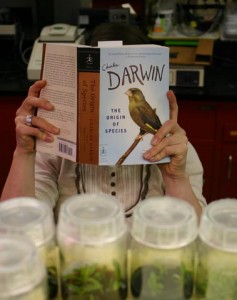
'The Origin of Species' may be 150 years old, but it can still hold its own in the Smithsonian’s research labs.
To mark the anniversary of Darwin’s landmark publication, here are two passages from the book; the first is from the introduction, the second is from the final page.
No one ought to feel surprised at much remaining as yet unexplained in regard to the origin of species and varieties, if he make due allowance for our profound ignorance in regard to the mutual relations of the many beings which live around us. Who can explain why one species ranges widely and is very numerous, and why another allied species has a narrow range and is rare? Yet these relations are of the highest importance, for they determine the present welfare and, as I believe, the future success and modification of every inhabitant of this world. Still less do we know of the mutual relations of the innumerable inhabitants of the world during the many past geological epochs in its history. Although much remains obscure, and will long remain obscure, I can entertain no doubt, after the most deliberate study and dispassionate judgment of which I am capable, that the view which most naturalists until recently entertained, and which I formerly entertained—namely, that each species has been independently created—is erroneous. I am fully convinced that species are not immutable; but that those belonging to what are called the same genera are lineal descendants of some other and generally extinct species, in the same manner as the acknowledged varieties of any one species are the descendants of that species. Furthermore, I am convinced that Natural Selection has been the most important, but not the exclusive, means of modification.
It is interesting to contemplate a tangled bank, clothed with many plants of many kinds, with birds singing on the bushes, with various insects flitting about, and with worms crawling through the damp earth, and to reflect that these elaborately constructed forms, so different from each other, and dependent upon each other in so complex a manner, have all been produced by laws acting around us. These laws, taken in the largest sense, being Growth with Reproduction; Inheritance which is almost implied by reproduction; Variability from the indirect and direct action of the conditions of life, and from use and disuse: a Ratio of Increase so high as to lead to a Struggle for Life, and as a consequence to Natural Selection, entailing Divergence of Character and the Extinction of less-improved forms. Thus, from the war of nature, from famine and death, the most exalted object which we are capable of conceiving, namely, the production of the higher animals, directly follows. There is grandeur in this view of life, with its several powers, having been originally breathed by the Creator into a few forms or into one; and that, whilst this planet has gone cycling on according to the fixed law of gravity, from so simple a beginning endless forms most beautiful and most wonderful have been, and are being evolved.
Listen to the recent broadcast of PRI’s Studio 360 for a look at the cultural impact of Darwin’s book.
‘Tidal Freshwater Wetlands’ gives an overlooked ecosystem its due
Posted by Kristen Goodhue on November 17th, 2009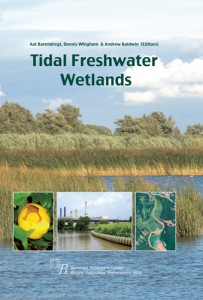
Tidal Freshwater Wetlands
Whigham, along with colleagues Aat Barendregt from Utrecht University and Andy Baldwin from the University of Maryland, has edited the new book Tidal Freshwater Wetlands. It’s a weighty work containing more than 20 chapters written by more than 40 authors. For the first time ever, they have systematically peeled back the layers of these overlooked coastal ecosystems. The book explores how these wetlands work, the animal and plant life they support, and the threats they face.
Click to continue »



